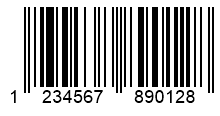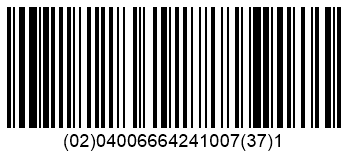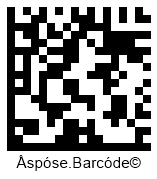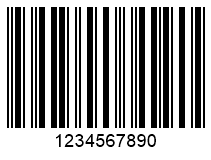Analyzing your prompt, please hold on...
An error occurred while retrieving the results. Please refresh the page and try again.
This article introduces general information about barcode types and describes their key properties along with providing sample barcode labels and code snippets to generate barcodes of different types.
A barcode is a graphical code composed of parallel lines and spaces of different widths or various figures combined in a visual pattern to encode data. After being generated and printed out, barcode labels get placed on scannable surfaces. Barcodes have been introduced as machine-readable tags to enable fast automatical information fetching from graphic data. A single barcode may correspond to approximately 25 characters for 1D types or 2,000 for 2D ones. The greater the number of characters to be encoded in a single barcode, the larger the generated barcode.
All types supported in Aspose.BarCode for PHP via Java are listed below.
Supported Barcode Types |
||
|---|---|---|
| 1D | Numerical Only | Code 11, Code 32, Codabar, DataBar Omnidirectional, DataBar Stacked Omnidirectional, DataBar Limited, DataBar Truncated, DataBar Stacked, EAN 13, EAN 14, EAN 8, IATA 2-of-5, Italian Post 25, Interleaved 2-of-5, ISBN, ISMN, ISSN, ITF 6, ITF 14, Matrix 2-of-5, MSI, OPC, Patch Code, Pharmacode, PZN, SSCC 14, SSCC 18, Standard 2-of-5, EAN 5, EAN 2, UPC-A, UPC-E, UpcaGs1DatabarCoupon |
| Alpha-Numeric | Code 128, Code 39, Code 93, Code 16K, CodablockF, DataBar Expanded, DataBar Expanded Stacked, GS1 CodablockF, GS1 Code 128, VIN | |
| 2D | QR Code, Micro QR Code, PDF417, Compact PDF417, Macro PDF417, Micro PDF417, Aztec Code, Data Matrix, DotCode, GS1 Data Matrix, GS1 QR Code, MaxiCode | |
| Postal | Australia Post, AustralianPostParcel, Deutsche Post Identcode, Deutsche Post Leticode, Planet, Postnet, RM4SCC, SingaporePost, Swiss Post Parcel, USPS OneCode | |
Aspose.BarCode for PHP via Java supports nearly all widely used barcode types. In general, to generate a barcode image, it is necessary to create an instance of class BarcodeGenerator with two main parameters to be initialized: data contents to be encoded using the setCodeText function and the barcode type in the setBarcodeType function. The setBarcodeType function is used to define the type of generated barcodes. Developers can assign any options to the setBarcodeType property from the list of predefined barcode types supported by class BarcodeGenerator. However, not all types enable barcode generation with input text in a required format due to the limitations of a barcode type itself.
Below, two barcode types, Code 39 and QR Code, are considered as examples to demonstrate how to generate barcodes.
Code 39
Code 39 is a barcode type with variable length. Its specification is limited to 43 characters, including uppercase letters (A-Z), numerical digits, and some special characters (-, ., $, /, +, %, and space). Each character is decoded by nine elements: five bars and four spaces. This type has low data density and does not allow ensuring recognition accuracy as it does not require setting an obligatory checksum by default.

QR Code
QR Code is a 2D type that is used to encode long strings of alphanumeric data, typically text or URL. A QR Code label is composed of an array of black and white squares that can be recognized by smartphones and other readers. The QR Code type provides high data encoding density. Moreover, it supports the Reed-Solomon error correction that allows not only to restore corrupted data but also to ensure correct information decoding.

Different types have different underlying data encoding approaches and capabilities. Accordingly, barcode label size and the amount of data to be encoded are predefined for each type. Some barcode types allow encoding only digits or a limited set of characters and digits, while others can accept any byte sequence without limitations.
Further in the article, several barcode types (EAN 13, Code 11, GS1 Code 128, and PDF417) with different data densities are presented as examples.
EAN 13
EAN 13 barcodes can encode only numerical digits. Specifically, the EAN 13 data encoding format requires encoding precisely 12 digits with the 13th one used as a control sum calculated according to the specified algorithm.

Code 11
Code 11 allows encoding a string of any length (theoretically, unlimited), including numerical digits and the dash sign (-).

GS1 Code 128
GS1 Code 128 can encode any of ASCII alphanumeric characters similarly to the basic Code 128 type. However, in GS1 Code 128, the data encoding format is defined strictly according to the GS1 standards.

PDF417
The PDF417 barcode is a 2D high-density type that is capable of encoding any sequence of bytes, including text, numbers, files, and actual data bytes. It supports the Reed-Solomon error correction and thus provides high recognition accuracy.

Data density is one of the most important properties of barcode types. It defines how much information can be encoded in a single barcode. It is low for 1D barcodes and considerably high for 2D matrix barcode types. The difference in data density for 2D and 1D types can exceed 10 times. The barcode types discussed below, Code93 and Data Matrix, are provided as examples of barcode types with different density values.
Code 93
Code 93 is a more secure and compact version of Code 39 that can encode both alphabet characters and numerical digits. Code 93 has quite low data density; therefore, with respect to other types, it requires generating larger barcodes to encode the same amounts of information.

Data Matrix
Data Matrix is a 2D code that allows encoding large amounts of data in a compact space. A single Data Matrix can contain up to 2,335 alphanumeric or 3,116 numerical characters. This is 10 times greater than the standard data density of 1D barcodes.

In general, the surfaces to place printed barcodes can have various shapes. At the same time, barcodes can be of rectangular or square forms only. Accordingly, if there is a large space to put a rectangular barcode, the generation of a square-shaped barcode is unacceptable from the viewpoint of space usage.
Further, two barcode types, Micro QR Code and Compact PDF417, are considered as examples of barcodes with different shapes.
Micro QR Code
Micro QR Code provides large data density; however, it has a square shape and thus needs square space to be placed. A major feature of MicroQR is that it has only one position detection pattern instead of three ones for regular QR Code and requires a more compact placement area.

Compact PDF417
Compact PDF417 can be used when space limitations are the main concern and barcode damage is unlikely. It has less data density compared with other 2D barcodes; however, owing to its property to have a length 64 times larger than height, it is more suitable for narrow rectangular areas with size limitations.

In some cases, the data fetched after barcode recognition may be incorrect. Generally, 1D barcodes do not include a checksum or contain only simple controls; accordingly, this may result in reading erroneous data from barcodes. In turn, the majority of 2D barcodes rely on the Reed-Solomon error correction, which allows ensuring correct barcode recognition and partially recovering the data from damaged barcodes.
The types outlined below, Interleaved 2-of-5 and Aztec Code, are considered as examples of barcode types with different recognition accuracy.
Interleaved 2-of-5
Interleaved 2-of-5 can encode sequences of digits of any length as long as such a sequence contains an even number of digits. By default, it does not require setting a checksum and thus can be read with errors.

Aztec Code
Aztec Code is a highly efficient 2D type that uses square modules with a unique finder pattern in the middle of a barcode, which allows barcode scanners to identify cell locations required for barcode reading. This barcode type not only enables encoding any sequence of bytes but also ensures correct data recognition.

Postal symbologies correspond to the specific industrial barcode types that are used only for the needs of postal services. They have much lower data density compared with 2D barcodes and are capable of encoding limited sets of characters, mainly, only numerical ones. Unlike traditional barcodes, postal types usually vary the height of bars to encode information. At present, postal services tend to replace specified postal types with widely used 2D barcodes. However, this transition process cannot be completed immediately; Aspose.Barcode for PHP via Java supports the most widely used postal types in addition to 1D and 2D ones.
Postnet
Postnet allows encoding only digits corresponding to ZIP or ZIP+4 codes in half- and full-height bars; its parameters are similar to those of 1D barcodes. In this barcode type, each digit is encoded by a set of five bars, two of which are of full height.
Two type considered below, Postnet and RM4SCC, are provided as examples of postal barcodes.

RM4SCC
RM4SCC is capable of encoding only digits and English alphabet capital characters. Its parameters are similar to those of 1D barcodes. In this barcode type, each character corresponds to four bars so that two of them are extended upwards and the other two - downwards. The combination of such bars with variable height provides combinations to encode 36 possible characters: 10 numerical and 26 alphabetical ones.

Analyzing your prompt, please hold on...
An error occurred while retrieving the results. Please refresh the page and try again.